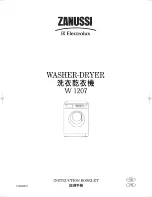
23
Saving Energy
Saving energy is important and helps you save money. This section gives you tips on the best
ways to save energy with your dishwasher.
Loading tips
•
Wash full loads. Running a half-filled
dishwasher uses the same amount of
electricity and hot water as a fully loaded
machine.
•
Load correctly for best washing results.
Incorrect loading may cause poor washing.
You will then need to rewash all or part
of load.
Cycle and option tips
•
Use the Light cycle whenever possible.
The cycle uses less hot water and energy
than the Normal cycle.
•
Run your dishwasher during off-peak hours.
The local utilities recommend that you
avoid using too much energy at certain
times of the day.
•
Do not use the Hi-Temp Wash option if it
is not needed. When this option is off and
water entering the dishwasher is lower than
140°F (60°C), the cycle does not take
additional time to heat water during the main
wash. In some cases, loads may not dry as
well when using the Hi-Temp Wash option.
NOTE:
Loads may not wash or dry as well
if the water temperature is too low. For
best dishwashing results, water must be
at least 120°F (49°C) as it enters the
dishwasher.
•
Use the Air Dry option whenever possible.
Allow longer drying times (overnight). Use
a rinse agent to improve drying.
•
Do not prerinse normally soiled dishes.
Select the correct cycle for the load and
use the recommended amount of detergent.
To check water temperature:
1.
Run the hot water at the faucet closest
to your dishwasher. Let the
water run for at least 1 minute.
2.
Hold a candy or meat thermometer in the
running stream of water. If
water temperature at the
faucet is below 120°F (49°C),
have a qualified person raise
the water heater’s thermostat
setting.
















































